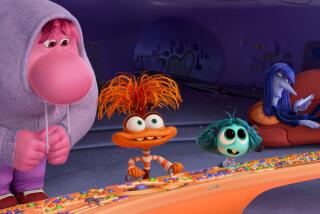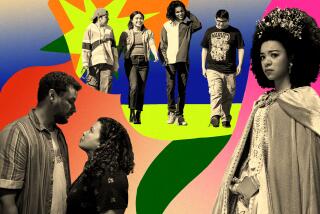In kids’ TV, it’s the end of the world. But don’t expect ‘gloom and doom’
- Share via
The postapocalyptic world of “Kipo and the Age of Wonderbeasts” includes lumberjack cats, rocker snakes and wolves that rap about science.
Full of giant mutant creatures called “mutes,” this fantastic and dangerous place would harden anybody trying to survive in it. But that doesn’t stop 13-year-old Kipo Oak from being excited about pretty much every new thing she encounters.
The first season of the DreamWorks animated series, now streaming on Netflix, follows Kipo (voiced by Karen Fukuhara) as she tries to reunite with her underground community after she has been flushed out into the surface world for the first time in her life.
Set around 200 years after the world has been turned into a whimsical wasteland, the show is anything but a bleak story about the end of civilization.
Despite the prevalence of postapocalyptic TV shows, from the gritty, zombie-centric “The Walking Dead” to the comedic “The Last Man on Earth,” children’s programming set after a global catastrophe is still rare.
The exceptions — “Kipo,” Cartoon Network’s “Adventure Time” and Netflix’s “The Last Kids on Earth” among them — present their postapocalyptic worlds as places of wonder and adventure, not to mention backdrops for standard adolescent issues like crushes and having a falling-out with friends.
Executive producer Bill Wolkoff told The Times in a recent phone interview that he and Radford Sechrist, “Kipo” creator and executive producer, wanted their apocalypse to be “dangerous but also a wonderland.”
Sechrist explained that his original plan for “Kipo,” initially envisioned as a web comic, was to go “super dark, like ‘Game of Thrones’ or ‘Walking Dead.’”
“But my drawing style just came out kind of fun,” Sechrist said. “I just kind of leaned into it.”
In the show, Kipo befriends surface-dwelling humans Wolf (Sydney Mikayla) and Benson (Coy Stewart), along with the talking insect Dave (Deon Cole) and four-eyed pig Mandu (Dee Bradley Baker). The new friends help Kipo navigate the dangers of the world and, in turn, learn that there is more to life than mere survival.
“We wanted to make the stakes real, and make the end of the world very real, but lean into the playfulness of what that could be,” said Wolkoff. “It doesn’t have to be dark, but it can be dangerous.”
In “Kipo’s” case, “playfulness” means many of the mutants out hunting humans are pretty cute on top of being deadly.
By contrast, the postapocalyptic setting of “Adventure Time” was initially downplayed — though it was no less cute.
“When I pitched [‘Adventure Time’], I didn’t pitch the apocalypse part of it — just the fun part,” creator Pendleton Ward told io9 in 2012. “They were like, ‘That sounds good!’ And then I put the apocalypse in the background. It’s not hit over the head in the show.”
Following the adventures of Finn the Human (Jeremy Shada) and Jake the Dog (John DiMaggio), the critically acclaimed series was a coming-of-age story set in a postapocalyptic world filled with magic. The first episode involved a potential zombie apocalypse of candy people — just one of the many crises Finn had to avert over the show’s 10 seasons.
The backstory of how the Land of Ooo came to be and the fate of the rest of humanity was revealed over the course of the series as Finn grew up and became aware of the complexities of the world. (As it turns out, it’s not just beating up bad guys and finding treasure.)
Though the Cartoon Network series ended its original run in 2018, four new specials, titled “Adventure Time: Distant Lands,” are in production for the forthcoming streaming service HBO Max.
“The Last Kids on Earth” executive producer and writer Max Brallier told The Times that when he first pitched the books that became the basis for the animated series, he was told the end-of-the-world scenario was “really sad” and that “the tone doesn’t work.”
“But in my head it seemed very fun,” said Brallier, who grew up with an appreciation for films such as “Dawn of the Dead,” “Mad Max” and “Waterworld.” “I just like end-of-the-world stories because there’s this sort of feeling of total freedom. That you kind of do whatever you want and get away with whatever you want.
“There’s no parents, there’s no rules, and it clicked with the way that I would daydream and imagine getting into adventures with my friends,” he continued. “Adventures that you couldn’t really have with grownups and rules around.”
Our guide to the original TV shows and movies, catalog titles, launch date, price and other features of WarnerMedia’s new streaming service, HBO Max.
Set in the aftermath of a mysterious zombie and monster outbreak, “Last Kids” follows Jack Sullivan (Nick Wolfhard) as he tries to thrive in this new world with his best friend Quint (Garland Whitt), his crush June (Montserrat Hernandez) and former bully Dirk (Charles Demers). He approaches challenges as if they are video game quests.
“One of the things we really tried to do with the series was focus on how much the kids are enjoying themselves while they’re in the apocalypse. It’s not gloom and doom,” said executive producer Scott Peterson. “Jack is an orphan, and so he actually likes life better in the apocalypse. He’s formed a new family, a family of choice, from the friends that he’s encountered. For him, this is the best time he’s ever had.”
Kipo’s endless positivity is key to seeing the bright side of her show’s postapocalyptic world.
“It can be scary thinking about your world changing in ways that you don’t recognize. But there’s also something really positive in that,” said Wolkoff. “That’s where the character Kipo really came into play for us. She’s the kind of person who can recognize and find the beauty and wonder in a world that everybody else would find very dangerous.”
One way such series maintain their optimism in the face of dire circumstances is by focusing on the importance of friendship.
“You’re thrown into a postapocalypse but you’re really kind of just watching these characters meet each other, and the muddiness of getting to know each other and overcoming your personal boundaries,” Sechrist said of “Kipo.”
For Brallier, it was important that the characters in “Last Kids” be “good people you want to spend time with.”
“Growing up, I always liked watching stuff where I felt like I wanted to be friends and hang out with the characters — be in their world and join their group of friends,” Brallier said. “I think that’s an important thing for kids who aren’t having their best days, so watching the show can hopefully feel like a sort of escape from everyday stuff.”
Still, the series’ sunniness isn’t without dimension: They also offer a model for kids navigating situations that may be out of their control.
“There’s an overarching theme [in ‘Last Kids’] of making the best of the cards that you’re dealt. This is a really bad situation they’re in, but the main character, Jack, is trying to not only survive but also have fun,” said Peterson. “That’s something we’re trying to sell the kids on — that you can make things better just by your attitude.”
“Kipo’s” Wolkoff shared similar sentiments.
“The draw of [working on ‘Kipo’] is giving kids a sense of power in a time when that can be really scary,” said Wolkoff. “Even though it seems like the world [is] ending, it’s gonna be OK.”
More to Read
The complete guide to home viewing
Get Screen Gab for everything about the TV shows and streaming movies everyone’s talking about.
You may occasionally receive promotional content from the Los Angeles Times.







